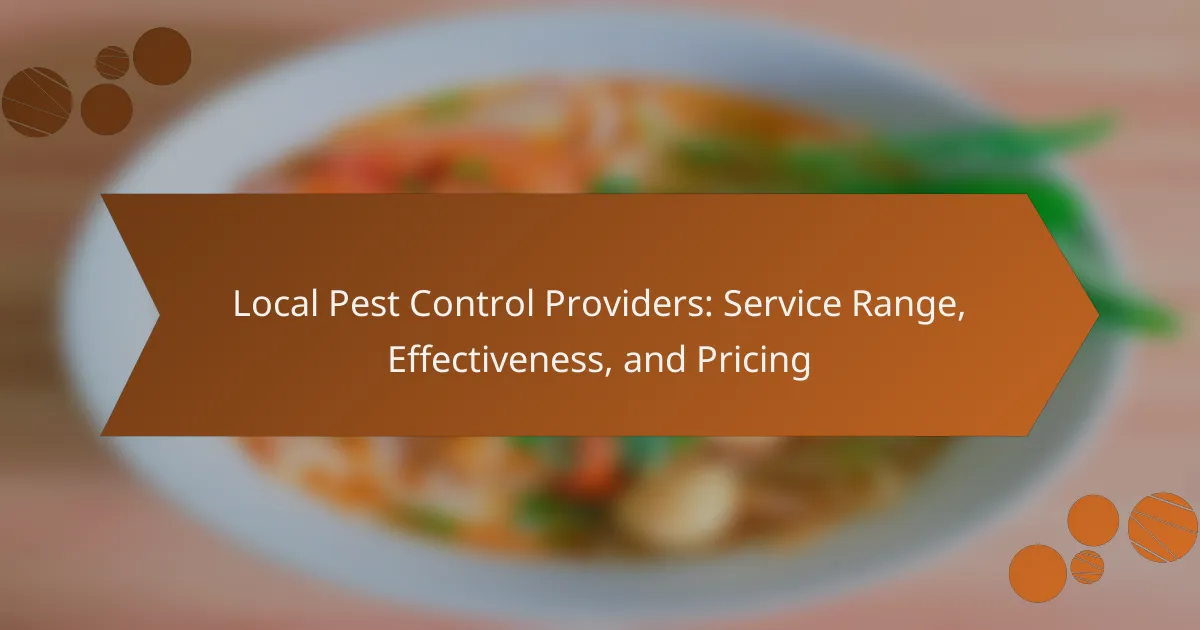In Los Angeles, a diverse range of pest control services is available to meet the needs of both residential and commercial clients, addressing common issues like rodents and bed bugs, as well as specialized treatments such as termite control. The effectiveness of local providers largely hinges on their methods and the specific pest challenges faced. Pricing can vary significantly, with initial treatments generally ranging from the low tens to several hundred dollars, while ongoing maintenance tends to be more affordable per visit.
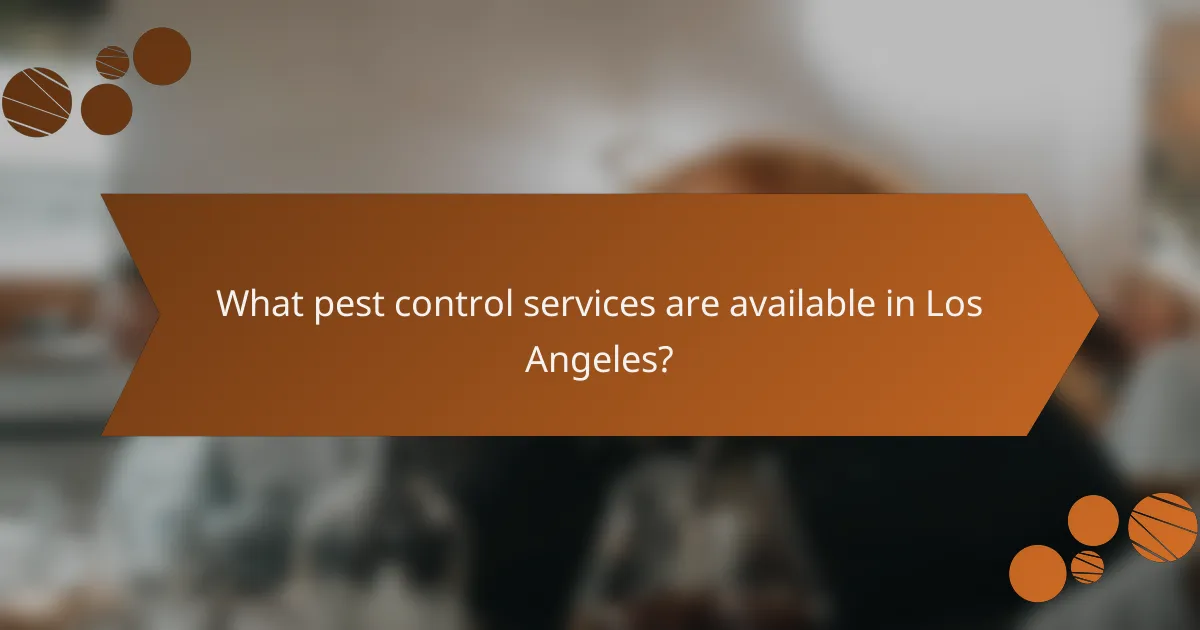
What pest control services are available in Los Angeles?
Los Angeles offers a variety of pest control services tailored to both residential and commercial needs. These services include targeted treatments for common pests, such as rodents and bed bugs, as well as specialized services like termite control.
Residential pest control
Residential pest control in Los Angeles focuses on eliminating common household pests such as ants, roaches, and spiders. Providers typically offer routine inspections and treatments, which can be scheduled monthly or quarterly, depending on the severity of the infestation.
Homeowners should consider integrated pest management (IPM) approaches that combine prevention, monitoring, and targeted treatments. This can be more effective and environmentally friendly.
Commercial pest control
Commercial pest control services cater to businesses, including restaurants, offices, and warehouses. These services are designed to minimize disruptions while ensuring compliance with health regulations.
Providers often create customized pest management plans that include regular inspections and treatments. Businesses should prioritize working with licensed professionals to ensure adherence to local health codes.
Termite control services
Termite control services in Los Angeles are crucial due to the region’s susceptibility to termite infestations. Treatments typically involve inspections, baiting systems, and liquid treatments to eliminate existing colonies and prevent future infestations.
Homeowners should consider annual inspections, especially if living in areas known for termite activity. Early detection can save thousands in potential damage repairs.
Rodent control services
Rodent control services address issues with mice and rats, which can pose health risks and cause property damage. Effective rodent control often involves a combination of trapping, baiting, and exclusion methods to prevent entry.
Property owners should regularly inspect for signs of rodent activity and seal any potential entry points. Professional services can provide comprehensive assessments and ongoing monitoring.
Bed bug treatments
Bed bug treatments are essential for addressing infestations in homes and hotels. These treatments often include heat treatments, chemical applications, and thorough inspections to identify and eliminate all life stages of bed bugs.
Property owners should act quickly upon discovering bed bugs, as they can multiply rapidly. Professional services can ensure effective eradication and provide guidance on preventing future infestations.
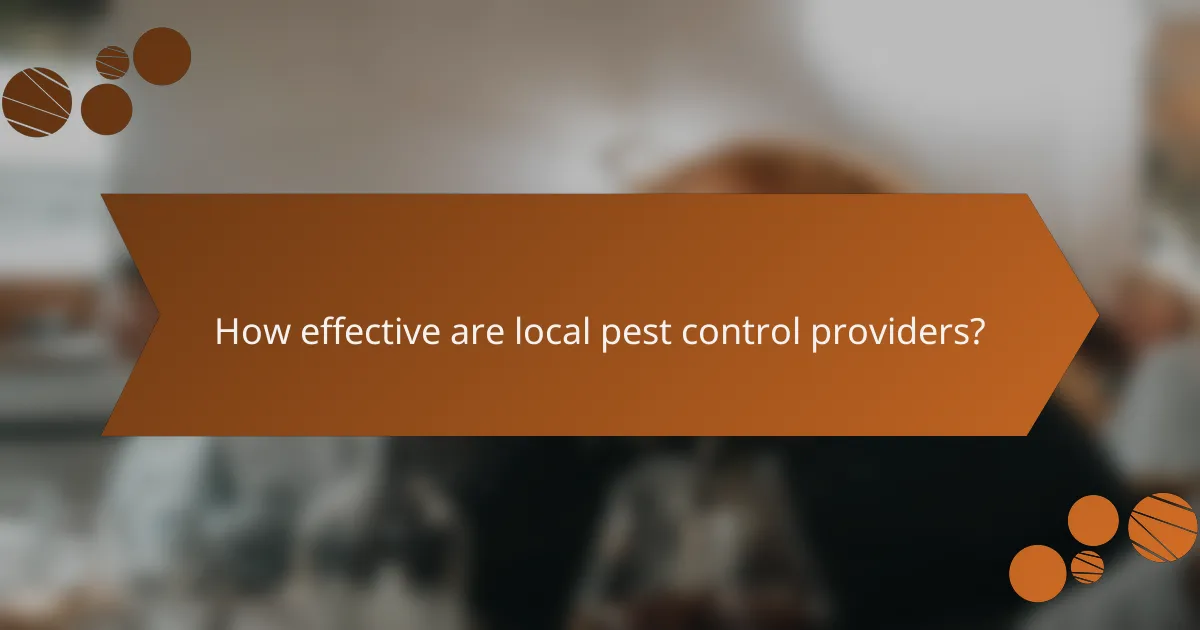
How effective are local pest control providers?
Local pest control providers can be highly effective in managing and eliminating pest infestations. Their success often depends on the methods used, the type of pests being targeted, and the specific circumstances of each situation.
Success rates of treatments
Success rates for pest control treatments can vary widely, typically ranging from 70% to 90% effectiveness. Factors influencing these rates include the pest species, the severity of the infestation, and the treatment method employed. For example, localized treatments for ants or cockroaches often yield higher success rates compared to broader approaches for termites.
Providers often offer follow-up assessments to ensure that treatments are effective and to address any remaining issues. Regular monitoring can significantly improve long-term success in pest management.
Customer satisfaction ratings
Customer satisfaction ratings for local pest control services generally hover around 80% to 90%. Clients appreciate timely responses, effective treatments, and professional service. Reviews on platforms like Google and Yelp can provide insights into a provider’s reliability and effectiveness.
It’s advisable to look for providers with a solid track record and positive testimonials. Engaging with local community forums can also help gauge customer experiences and satisfaction levels.
Comparison of chemical vs. organic methods
Chemical methods often provide faster results and are typically more effective for severe infestations, while organic methods tend to be safer for the environment and human health. Chemical treatments can eliminate pests quickly but may pose risks if not applied correctly.
Organic methods, such as diatomaceous earth or essential oils, are generally less harmful but may require more frequent applications and longer timeframes to achieve desired results. Homeowners should weigh the urgency of pest removal against their preferences for safety and environmental impact when choosing between these methods.
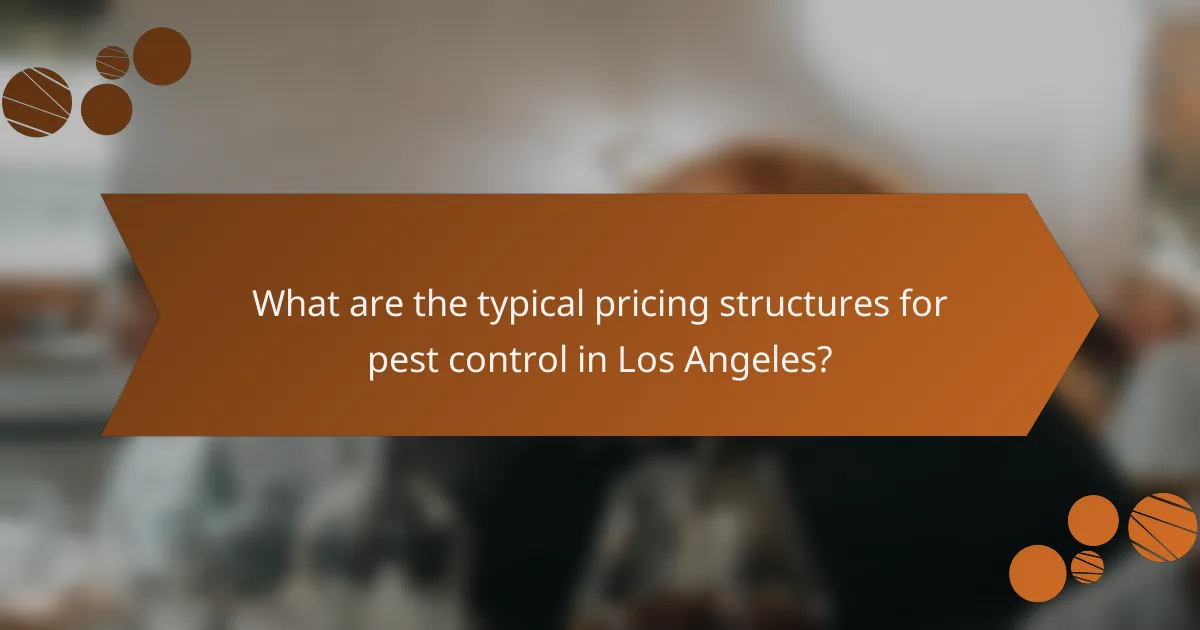
What are the typical pricing structures for pest control in Los Angeles?
The pricing structures for pest control in Los Angeles can vary widely based on the type of service, the size of the property, and the specific pest issues being addressed. Generally, homeowners can expect to pay anywhere from low tens to a few hundred dollars for initial treatments, with ongoing maintenance services typically costing less per visit.
Average cost for residential services
For residential pest control services in Los Angeles, initial treatments usually range from $100 to $300, depending on the severity of the infestation and the size of the home. Monthly maintenance plans can cost between $40 and $70, offering a more economical option for ongoing pest management.
Some companies may offer package deals that include multiple treatments over a specified period, which can provide additional savings. Homeowners should compare quotes from different providers to find the best value for their needs.
Commercial service pricing
Commercial pest control pricing in Los Angeles often starts higher than residential services due to the larger scale and complexity of the properties involved. Businesses can expect to pay between $150 and $500 for initial inspections and treatments, depending on the type of establishment and the pests targeted.
Ongoing services for commercial properties typically range from $100 to $300 per month, with customized plans available based on specific industry requirements, such as food safety regulations for restaurants.
Factors influencing pricing
Several factors can influence the pricing of pest control services in Los Angeles. The type of pest being treated, the extent of the infestation, and the size of the property are primary considerations. For example, termite treatments may be more expensive due to the specialized methods and materials required.
Additionally, the frequency of service and the inclusion of preventative measures can affect overall costs. Companies may also charge extra for emergency services or specialized treatments, so it’s advisable to clarify all potential fees before committing to a service agreement.

What should you consider when choosing a pest control provider?
When selecting a pest control provider, prioritize their qualifications, experience, and service offerings. Understanding these factors will help ensure effective pest management tailored to your needs.
Licensing and certifications
Verify that the pest control provider holds the necessary licenses and certifications required by local regulations. These credentials indicate that the company adheres to industry standards and safety protocols.
Look for certifications from recognized organizations, such as the National Pest Management Association (NPMA) or local pest control associations. These affiliations often reflect a commitment to ongoing training and best practices.
Experience and reputation
Consider the provider’s experience in the pest control industry. Companies with several years of operation typically have a proven track record of effectively managing various pest issues.
Research customer reviews and testimonials to gauge the provider’s reputation. A strong reputation often correlates with reliable service and customer satisfaction, which can be critical in pest management.
Service guarantees and warranties
Inquire about service guarantees and warranties offered by the pest control provider. A solid guarantee can provide peace of mind, ensuring that if pests return, the company will address the issue at no additional cost.
Compare the terms of warranties among different providers. Some may offer longer coverage periods or more comprehensive services, which can be a deciding factor in your choice.
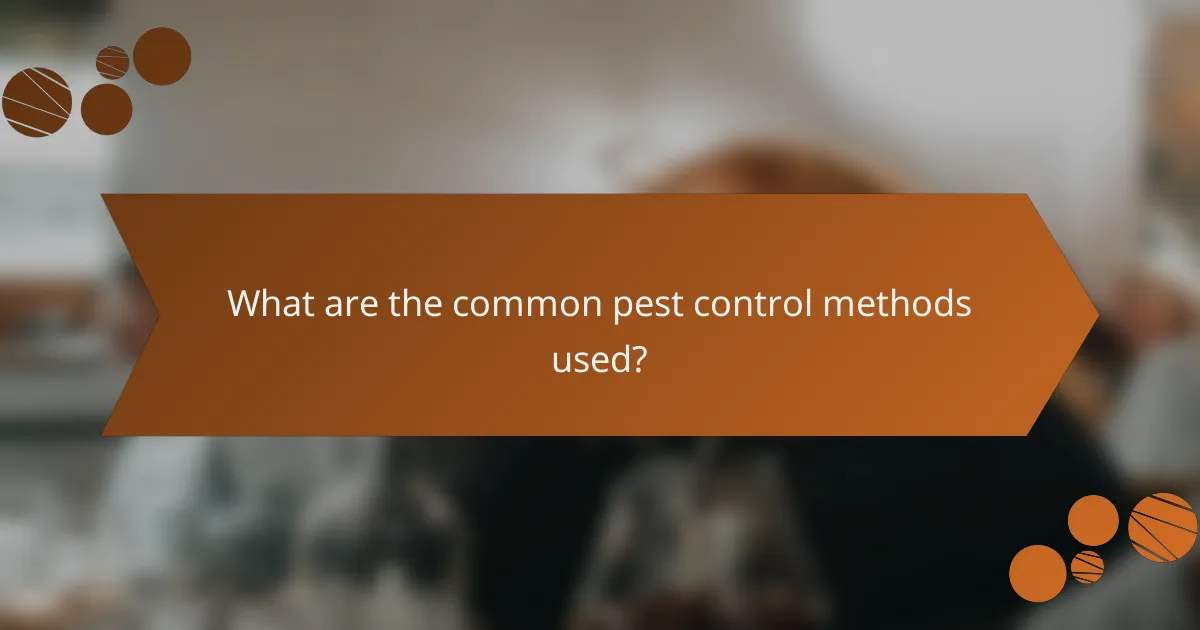
What are the common pest control methods used?
Common pest control methods include chemical treatments, integrated pest management, and preventative measures. Each method varies in effectiveness, application, and cost, making it essential to choose the right approach based on the specific pest issue and environment.
Chemical treatments
Chemical treatments involve the use of pesticides to eliminate pests quickly. These substances can be applied as sprays, baits, or granules and are effective against a wide range of pests, including insects and rodents.
While chemical methods can provide immediate results, they may pose health risks to humans and pets if not used correctly. Always follow label instructions and consider hiring a licensed professional for application to ensure safety and compliance with local regulations.
Integrated pest management
Integrated pest management (IPM) combines various strategies to manage pest populations effectively while minimizing risks to human health and the environment. This approach includes monitoring pest activity, using biological controls, and applying chemical treatments only when necessary.
IPM is often more sustainable and cost-effective in the long run, as it focuses on prevention and long-term solutions rather than quick fixes. Homeowners can implement IPM by maintaining clean environments, sealing entry points, and using traps to monitor pest activity.
Preventative measures
Preventative measures aim to reduce the likelihood of pest infestations before they occur. Common strategies include regular cleaning, proper food storage, and sealing cracks and crevices in buildings.
Implementing these measures can significantly decrease the chances of pests entering your home. Simple actions like removing standing water, keeping gardens tidy, and using screens on windows can create an inhospitable environment for pests, ultimately saving money on pest control services.
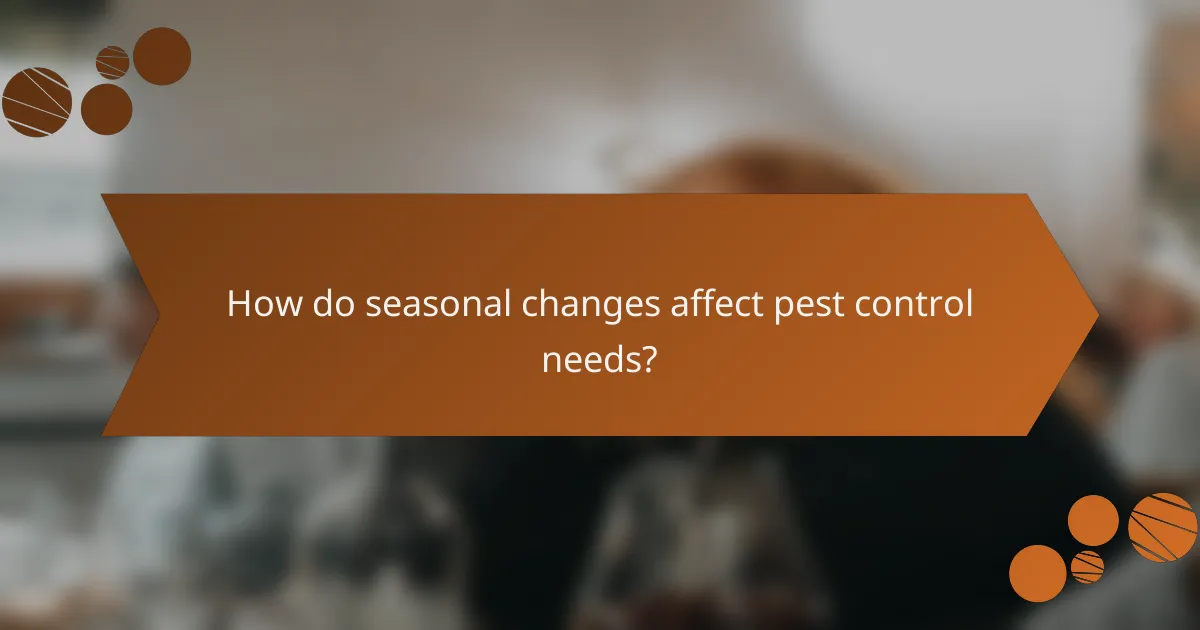
How do seasonal changes affect pest control needs?
Seasonal changes significantly impact pest control needs by altering pest behavior and population dynamics. Different pests thrive in various seasons, necessitating tailored pest management strategies throughout the year.
Spring: Increased Activity and Reproduction
In spring, warmer temperatures and increased moisture lead to heightened pest activity and reproduction. Common pests such as ants, termites, and mosquitoes become more active as they emerge from hibernation or complete their life cycles. Homeowners should prepare for potential infestations by scheduling preventive treatments early in the season.
Effective spring pest control often includes inspections for signs of infestations and implementing barriers or treatments to deter pests. Regular maintenance of yards and gardens can also minimize breeding grounds for mosquitoes and other insects.
Summer: Peak Infestation Period
Summer is typically the peak season for many pests, including flies, wasps, and ticks. The warm weather creates ideal conditions for these pests to thrive, making it crucial to monitor and manage infestations proactively. Homeowners should be vigilant about sealing entry points and maintaining cleanliness to reduce attractants.
During this season, pest control providers may recommend more frequent treatments to address the heightened activity. Outdoor spaces should be treated regularly, especially in areas where people gather, to ensure a pest-free environment.
Fall: Preparation for Winter
As temperatures drop in fall, many pests seek shelter indoors, increasing the likelihood of infestations in homes. Rodents and spiders are particularly common during this time, as they look for warm places to nest. Homeowners should focus on sealing cracks and gaps in their homes to prevent these pests from entering.
Fall pest control strategies often involve thorough inspections and treatments aimed at preventing overwintering pests. It’s advisable to schedule a professional assessment to identify vulnerabilities and implement necessary measures before winter sets in.
Winter: Dormancy and Monitoring
In winter, many pests enter a dormant state, but this does not eliminate the need for pest control. Some pests, like rodents, remain active and can cause significant damage if left unchecked. Regular monitoring and preventive measures are essential to ensure that pests do not take advantage of the colder months.
Winter pest control may include setting traps and monitoring for signs of activity. Homeowners should remain vigilant and consider scheduling inspections to address any potential issues before spring arrives.
